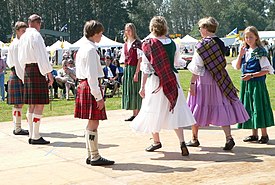
Contra dance is a form of folk dancing made up of long lines of couples. It has mixed origins from English country dance, Scottish country dance, and French dance styles in the 17th century. Sometimes described as New England folk dance or Appalachian folk dance, contra dances can be found around the world, but are most common in the United States, Canada, and other Anglophone countries.

Regency dance is the term for historical dances of the period ranging roughly from 1790 to 1825. Some feel that the popular use of the term "Regency dance" is not technically correct, as the actual English Regency lasted only from 1811 until 1820. However, the term "Regency" has been used to refer to a much broader period than the historical Regency for a very long time, particularly in areas such as the history of art and architecture, literature, and clothing. This is because there are consistencies of style over this period which make having a single term useful.
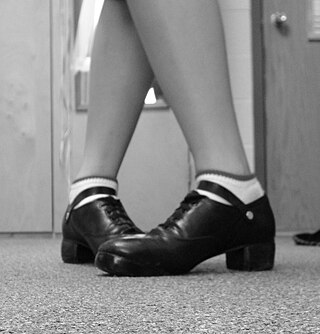
The reel is a folk dance type as well as the accompanying dance tune type. Of Scottish origin, reels are also an important part of the repertoire of the fiddle traditions of Britain, Ireland and North America. In Scottish country dancing, the reel is one of the four traditional dances, the others being the jig, the strathspey and the waltz, and is also the name of a dance figure.

The jig is a form of lively folk dance in compound metre, as well as the accompanying dance tune. It first gained popularity in 16th-century England, Ireland, Scotland, and other parts of the British Isles, and was adopted on mainland Europe where it eventually became the final movement of the mature Baroque dance suite. Today it is most associated with Irish dance music, Scottish country dance and the Métis people in Canada. Jigs were originally in quadruple compound metre,, but have been adapted to a variety of time signatures, by which they are often classified into groups, including double jigs, slip jigs and single jigs.

A country dance is any of a very large number of social dances of a type that originated in the British Isles; it is the repeated execution of a predefined sequence of figures, carefully designed to fit a fixed length of music, performed by a group of people, usually in couples, in one or more sets. The figures involve interaction with your partner and/or with other dancers, usually with a progression so that you dance with everyone in your set. It is common in modern times to have a "caller" who teaches the dance and then calls the figures as you dance. Country dances are done in many different styles.
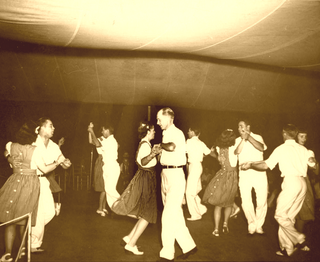
A square dance is a dance for four couples, or eight dancers in total, arranged in a square, with one couple on each side, facing the middle of the square. Square dances are part of a broad spectrum of dances known by various names: country dances, traditional dances, folk dances, barn dances, ceilidh dances, contra dances, Playford dances, etc. These dances appear in over 100 different formations, of which the Square and the Longways Set are by far the most popular formations.

Irish dance refers to a group of traditional dance forms that originate in Ireland, encompassing dancing both solo and in groups, and dancing for social, competitive, and performance purposes. Irish dance in its current form developed from various influences such as earlier native Irish dance, English country dancing and later possibly French quadrilles, as it became popular in Britain and Ireland during the 19th century. Dance was taught by "travelling dance masters" across Ireland in the 17th and 18th centuries, and separate dance forms developed according to regional practice and differing purposes. Irish dance became a significant part of Irish culture, particularly for Irish nationalist movements. From the early 20th century, a number of organisations promoted and codified the various forms of dance, creating competitive structures and standardised styles. Irish dancers who compete for competitive reasons dance in a dance style that is more modern than traditional Irish dance. It is mainly done solo, but there is some team dancing in groups of 2, 3, 4, 6, 8, 10, 16 and even numbers onwards.

The schottische is a partnered country dance that apparently originated in Bohemia. It was popular in Victorian era ballrooms as a part of the Bohemian folk-dance craze and left its traces in folk music of countries such as Argentina, Finland ("jenkka"), France, Italy, Norway ("reinlender"), Portugal and Brazil, Spain (chotis), Sweden, Denmark ("schottis"), Mexico, and the United States, among other nations. The schottische is considered by The Oxford Companion to Music to be a kind of slower polka, with continental-European origin.

A cèilidh or céilí is a traditional Scottish and Irish social gathering. In its most basic form, it simply means a social visit. In contemporary usage, it usually involves dancing and playing Gaelic folk music, either at a home or a larger concert at a social hall or other community gathering place.

The hornpipe is any of several dance forms played and danced in Britain and Ireland and elsewhere from the 16th century until the present day. The earliest references to hornpipes are from England, with Hugh Aston's Hornepype of 1522 and others referring to Lancashire hornpipes in 1609 and 1613.
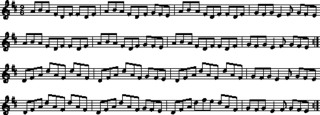
Slip jig refers to both a style within Irish music, and the Irish dance to music in slip-jig time. The slip jig is in 9
8 time, traditionally with accents on 5 of the 9 beats — two pairs of crotchet/quaver followed by a dotted crotchet note.
A strathspey is a type of dance tune in 4
4 time, featuring dotted rhythms, which in traditional playing are generally somewhat exaggerated rhythmically. Examples of strathspeys are the songs "The Bonnie Banks o' Loch Lomond" and "Coming Through the Rye".
The Virginia reel is a folk dance that dates from the 17th century. Though the reel may have its origins in Scottish country dance and the Highland reel, and perhaps have an even earlier origin from an Irish dance called the Rinnce Fada, it is generally considered to be an English country dance. The dance was most popular in America from 1830–1890.

Highland dance or Highland dancing is a style of competitive dancing developed in the Scottish Highlands in the 19th and 20th centuries, in the context of competitions at public events such as the Highland games. It was created from the Gaelic folk dance repertoire, but formalised with the conventions of ballet, and has been subject to influences from outside the Highlands. Highland dancing is often performed with the accompaniment of Highland bagpipe music, and dancers wear specialised shoes called ghillies or pumps. It is now seen at nearly every modern-day Highland games event.
The Grandfather Mountain Highland Games is a Highland games event that has been held annually since 1956 at Grandfather Mountain, North Carolina. Celebrating the history and culture of Scots in North Carolina, it is among the first and largest modern Highland games established in the United States. Competitions and displays take place in Scottish styles of piping, drumming, costume, dance, and traditional sports.
"Brochan Lom" is a Scottish Gaelic nonsense song about porridge. The tune is popular and appears frequently at Scottish country dances and ceilidhs. It falls into the category of "mouth music", used to create music for dancing in the absence of instruments. It is a strathspey song and is commonly sung or played for the Highland Schottische, and for the Highland Fling.

Muriel Johnstone is a Scottish pianist and composer. She was raised and schooled in Ardrossan, Ayrshire, Scotland.
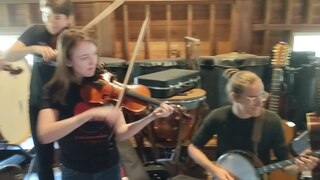
"Money Musk", alternatively "Monymusk" or other variations, is a contra dance first published in 1786. It was named after a 1776 strathspey by Daniel Dow which is played to accompany it, which itself was named after the House of Monymusk baronial estate. The dance features a central theme of reoriented lines, and is regarded as moderately difficult. It is still widely danced today, and is considered a traditional "chestnut".
